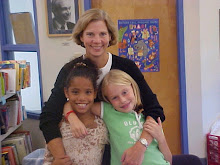Friday, September 27, 2013
Muddy Boots Club
I had as much fun as the kids finding fall leaves and leaping frogs in Muddy Boots Club this afternoon!
Thursday, September 26, 2013
Can children grow up without play?
Here is an interesting article about playing and how it is an essential way for children to learn about the world, themselves and others: The Play Deficit by evolutionary psychologist Peter Gray. Through play kids learn negotiation, empathy, inginuity and other skills that have been identified as markers for success in life.
Having grown up in a time in the 50's and 60's that the author talks about as being the golden years for children's play - when childhood was completely filled with unstructured time for wandering, getting into and out of trouble, and running with a gang of mixed age neighborhood kids, maybe it is just my nostalgia that makes Gray's ideas ring true. But watching children at Parker every day and seeing their real need - and joy - to run, tumble, tussle, build, dig and interact with imagination, I think he and other educators and psycholigsts are on the right track.
Maybe that's why I love Planet Parker summer camp and Muddy Boots Club and why I feel so strongly that we need to carve out a place for play at school.
What are your thoughts? What challenges do we face?
Monday, September 23, 2013
Failure invites learning
Here is a great visual from an article called Learning and Failure by David Truss. He says that failure can be an amazing tool for learning.
This is why risk-taking is on the list of skills in our progress reports. By taking risks intellectually, physically and in their social lives children have the opportunity to tackle something hard where failure is a possibility. Spending the night at Camp Chingachgook, even when they are nervous. Going back to the drawing board 15 times to get a robot to travel in a square. Offering an opposing opinion in a class discussion.
Because we push students to test their limits and offer "spotters" to catch them if they fall, we reinforce the "try, try again" mentality and build confidence and resilience. I love the little poem that a math teacher taught me years ago, "Mistakes are good, they help us grow, they teach us what we need to know."
This is why risk-taking is on the list of skills in our progress reports. By taking risks intellectually, physically and in their social lives children have the opportunity to tackle something hard where failure is a possibility. Spending the night at Camp Chingachgook, even when they are nervous. Going back to the drawing board 15 times to get a robot to travel in a square. Offering an opposing opinion in a class discussion.
Because we push students to test their limits and offer "spotters" to catch them if they fall, we reinforce the "try, try again" mentality and build confidence and resilience. I love the little poem that a math teacher taught me years ago, "Mistakes are good, they help us grow, they teach us what we need to know."
Tuesday, September 17, 2013
The 77 acre classroom
There is probably nothing at school that is cooler than going outside to find new things on a beautiful day. How lucky we are that such beauty is in our backyard!
Friday, September 13, 2013
Breathing for mindfulness
Learning to channel attention to productive tasks, to sustain motivation when work becomes demanding, and to handle the frustrations of sharing, learning, and communicating with peers are skills that depend on the ability to understand and manage emotions.
As one part of our effort to help children build emotional resiliency and self control, we use mindfulness techniques with them every day. Our faculty has worked with CS Rao, a grandparent in our school, to learn a form of breathing that allows us to quickly relax and tune out distractions. He calls it Counting Breaths and it has the effect of feeding oxygen to the brain, calming emotions, clearing a busy mind, and giving a sense of peace and focus.
Teachers have adapted CS's ideas for classroom practice. In Pre K 3, a chime is rung and children breathe smoothly and quietly as the chime sound deminishes. In Pre K 4, students use the image of falling leaves while they breathe. In K-1, Liliana has adopted the language "going into your silence" as children sit quietly in both mind and body and breathe slowly. 2-3's practice taking five slow clearing breaths as do the 4-5's.
This year middle school teachers are going to teach the students CS's method of using the fingers to count breaths. As CS says, the technique can be used anytime - when you can't sleep at night, or if you are feeling anxious. And it works! I use it in the middle of the night when my mind is racing.
The effect with children is very positive. They have a strategy to calm themselves that they can use anywhere. It is a great tool for successfully negotiating frustrations, stress and anxiety and gaining attentiveness and focus. Having the ability to be mindful gives children confidence that they can handle difficult things. That is a gift for any individual.
You can read more in this complex and fascinating article Why Teaching Mindfulness Benefits Students' Learning, in Mind/Shift.
Subscribe to:
Posts (Atom)


















